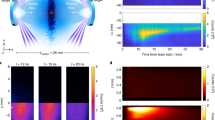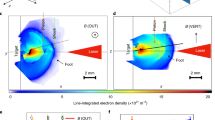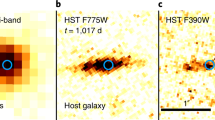Abstract
Astrophysical shocks at all scales, from those in the heliosphere up to cosmological shock waves, are typically ‘collisionless’, because the thickness of their jump region is much shorter than the collisional mean free path. Across these jumps, electrons, protons and ions are expected to be heated at different temperatures. Supernova remnants (SNRs) are ideal targets to study collisionless processes because of their bright post-shock emission and fast shocks, but the actual dependence of the post-shock temperature on the particle mass is still widely debated1. We tackle this longstanding issue through the analysis of deep multi-epoch and high-resolution observations, made with the Chandra X-ray telescope, of the youngest nearby supernova remnant, SN 1987A. We introduce a data analysis method by studying the observed spectra in close comparison with a dedicated full three-dimensional hydrodynamic simulation that self-consistently reproduces the broadening of the spectral lines of many ions together. We measure the post-shock temperature of protons and ions through comparison of the model with observations. Our results show that the ratio of ion temperature to proton temperature is always significantly higher than one and increases linearly with the ion mass for a wide range of masses and shock parameters.
This is a preview of subscription content, access via your institution
Access options
Access Nature and 54 other Nature Portfolio journals
Get Nature+, our best-value online-access subscription
$29.99 / 30 days
cancel any time
Subscribe to this journal
Receive 12 digital issues and online access to articles
$119.00 per year
only $9.92 per issue
Buy this article
- Purchase on Springer Link
- Instant access to full article PDF
Prices may be subject to local taxes which are calculated during checkout




Similar content being viewed by others
Data availability
The HD simulations adopted here are presented in detail in ref. 24. The Chandra dataset analysed are available in the Chandra Data Archive (http://cxc.harvard.edu/cda/). Other relevant data are available from the corresponding author upon reasonable request.
References
Ghavamian, P., Schwartz, S. J., Mitchell, J., Masters, A. & Laming, J. M. Electron–ion temperature equilibration in collisionless shocks: the supernova remnant–solar wind connection. Space Sci. Rev. 178, 633–663 (2013).
Landau, L. D. & Lifshitz, E. M. Fluid Mechanics (Pergamon, Oxford, 1959).
Bykov, A. M., Dolag, K. & Durret, F. Cosmological shock waves. Space Sci. Rev. 134, 119–140 (2008).
Vink, J. Supernova remnants: the X-ray perspective. Astron. Astrophys. Review 20, 49 (2012).
Tsurutani, B. T. & Stone, R. G. (eds) Collisionless Shocks in the Heliosphere: Reviews of Current Research Geophysical Monograph Series, Vol. 35 (American Geophysical Union, 1985).
Chevalier, R. A. & Raymond, J. C. Optical emission from a fast shock wave—the remnants of Tycho’s supernova and SN 1006. Astrophys. J. 225, L27–L30 (1978).
Chevalier, R. A., Kirshner, R. P. & Raymond, J. C. The optical emission from a fast shock wave with application to supernova remnants. Astrophys. J. 235, 186–195 (1980).
Raymond, J. C. Shock waves in supernova ejecta. Space Sci. Rev. 214, 28 (2018).
Rakowski, C. E., Ghavamian, P. & Hughes, J. P. The physics of supernova remnant blast waves. II. Electron–ion equilibration in DEM L71 in the Large Magellanic Cloud. Astrophys. J. 590, 846–857 (2003).
van Adelsberg, M., Heng, K., McCray, R. & Raymond, J. C. Spatial structure and collisionless electron heating in balmer-dominated shocks. Astrophys. J. 689, 1089–1104 (2008).
Ghavamian, P., Laming, J. M. & Rakowski, C. E. A physical relationship between electron-proton temperature equilibration and mach number in fast collisionless shocks. Astrophys. J. 654, L69–L72 (2007).
Rakowski, C. E., Laming, J. M. & Ghavamian, P. The heating of thermal electrons in fast collisionless shocks: the integral role of cosmic rays. Astrophys. J. 684, 348–357 (2008).
Vink, J., Broersen, S., Bykov, A. & Gabici, S. On the electron–ion temperature ratio established by collisionless shocks. Astron. Astrophys. 579, A13 (2015).
Shimada, N. & Hoshino, M. Strong electron acceleration at high Mach number shock waves: simulation study of electron dynamics. Astrophys. J. 543, L67–L71 (2000).
Park, J., Caprioli, D. & Spitkovsky, A. Simultaneous acceleration of protons and electrons at nonrelativistic quasiparallel collisionless shocks. Phys. Rev. Lett. 114, 085003 (2015).
Korreck, K. E., Raymond, J. C., Zurbuchen, T. H. & Ghavamian, P. Far ultraviolet spectroscopic explorer observation of the nonradiative collisionless shock in the remnant of SN 1006. Astrophys. J. 615, 280–285 (2004).
Berdichevsky, D., Geiss, J., Gloeckler, G. & Mall, U. Excess heating of 4He2+ and O6+ relative to H+ downstream of interplanetary shocks. J. Geophys. Res. 102, 2623–2636 (1997).
Raymond, J. C., Winkler, P. F., Blair, W. P. & Laming, J. M. Ion–ion equilibration and particle distributions in a 3000 km s1 shock in SN 1006. Astrophys. J. 851, 12 (2017).
Broersen, S. et al. The northwestern ejecta knot in SN 1006. Astron. Astrophys. 552, A9 (2013).
Vink, J., Laming, J. M., Gu, M. F., Rasmussen, A. & Kaastra, J. S. The slow temperature equilibration behind the shock front of SN 1006. Astrophys. J. 587, L31–L34 (2003).
West, R. M., Lauberts, A., Schuster, H.-E. & Jorgensen, H. E. Astrometry of SN 1987A and Sanduleak-69 202. Astron. Astrophys. 177, L1–L3 (1987).
McCray, R. Supernova 1987A revisited. Annu. Rev. Astron. Astr. 31, 175–216 (1993).
McCray, R. & Fransson, C. The remnant of supernova 1987A. Annu. Rev. Astron. Astr. 54, 19–52 (2016).
Orlando, S., Miceli, M., Pumo, M. L. & Bocchino, F. Supernova 1987A: a template to link supernovae to their remnants. Astrophys. J. 810, 168 (2015).
Spitzer, L. Physics of Fully Ionized Gases 2nd edn (Interscience, New York, 1962).
Frank, K. A. et al. Chandra observes the end of an era in SN 1987A. Astrophys. J. 829, 40 (2016).
Zhekov, S. A., McCray, R., Borkowski, K. J., Burrows, D. N. & Park, S. Chandra observations of shock kinematics in supernova remnant 1987A. Astrophys. J. 628, L127–L130 (2005).
Zhekov, S. A. et al. High-resolution X-ray spectroscopy of SNR 1987A: Chandra LETG and HETG observations in 2007. Astrophys. J. 692, 1190–1204 (2009).
Dewey, D., Dwarkadas, V. V., Haberl, F., Sturm, R. & Canizares, C. R. Evolution and hydrodynamics of the very broad X-ray line emission in SN 1987A. Astrophys. J. 752, 103 (2012).
Caprioli, D., Yi, D. T. & Spitkovsky, A. Chemical enhancements in shock-accelerated particles: ab initio simulations. Phys. Rev. Lett. 119, 171101 (2017).
Zanardo, G. et al. Detection of linear polarization in the radio remnant of supernova 1987A. Astrophys. J. 861, L9 (2018).
Narayan, R. & Medvedev, M. V. Thermal conduction in clusters of galaxies. Astrophys. J. 562, L129–L132 (2001).
France, K. et al. HST-COS observations of hydrogen, helium, carbon, and nitrogen emission from the SN 1987A reverse shock. Astrophys. J. 743, 186 (2011).
Orlando, S., Drake, J. J. & Laming, J. M. Three-dimensional modeling of the asymmetric blast wave from the 2006 outburst of RS Ophiuchi: early X-ray emission. Astron. Astrophys. 493, 1049–1059 (2009).
Miceli, M., Orlando, S., Reale, F., Bocchino, F. & Peres, G. Hydrodynamic modelling of ejecta shrapnel in the Vela supernova remnant. Mon. Not. R. Astron. Soc. 430, 2864–2872 (2013).
Park, S. et al. Evolutionary status of SNR 1987A at the age of eighteen. Astrophys. J. 646, 1001–1008 (2006).
Sugerman, B. E. K., Crotts, A. P. S., Kunkel, W. E., Heathcote, S. R. & Lawrence, S. S. The three-dimensional circumstellar environment of SN 1987A. Astrophys. J. Suppl. S. 159, 60–99 (2005).
Dewey, D., Zhekov, S. A., McCray, R. & Canizares, C. R. Chandra HETG spectra of SN 1987A at 20 years. Astrophys. J. 676, L131 (2008).
Acknowledgements
The software used in this work was, in part, developed by the US Department of Energy-supported Advanced Simulation and Computing/Alliance Center for Astrophysical Thermonuclear Flashes at the University of Chicago. We acknowledge that the results of this research have been achieved using the PRACE Research Infrastructure resource MareNostrum III based in Spain at the Barcelona Supercomputing Center (PRACE Award no. 2012060993). The scientific results reported in this article are based to a significant degree on data obtained from the Chandra Data Archive. M.M., S.O., G.P. and F.B. acknowledge financial contribution from the agreement ASI-INAF n.2017-14-H.O. O.P. acknowledges partial support from the agreement 0118U004941.
Author information
Authors and Affiliations
Contributions
M.M. composed the text on the basis of inputs from all authors. M.M. designed the analysis procedure and led the analysis of the synthetic and actual X-ray spectra. S.O. led the set-up and run of the hydrodynamics simulation and the synthesis of X-ray spectra. D.N.B., K.A.F. and C.A. supported the X-ray data analysis process. F.R., G.P., O.P. and F.B. supported the analysis of the simulation and the synthesis of observables. All authors helped to discuss the results and to comment on the manuscript.
Corresponding author
Ethics declarations
Competing interests
The authors declare no competing interests.
Additional information
Publisher’s note: Springer Nature remains neutral with regard to jurisdictional claims in published maps and institutional affiliations.
Supplementary information
Supplementary Information
Supplementary Figures 1–5, Supplementary Tables 1–2.
Rights and permissions
About this article
Cite this article
Miceli, M., Orlando, S., Burrows, D.N. et al. Collisionless shock heating of heavy ions in SN 1987A. Nat Astron 3, 236–241 (2019). https://doi.org/10.1038/s41550-018-0677-8
Received:
Accepted:
Published:
Issue Date:
DOI: https://doi.org/10.1038/s41550-018-0677-8
This article is cited by
-
Particle energization in space plasmas: towards a multi-point, multi-scale plasma observatory
Experimental Astronomy (2022)
-
The Voyage of Metals in the Universe from Cosmological to Planetary Scales: the need for a Very High-Resolution, High Throughput Soft X-ray Spectrometer
Experimental Astronomy (2021)



